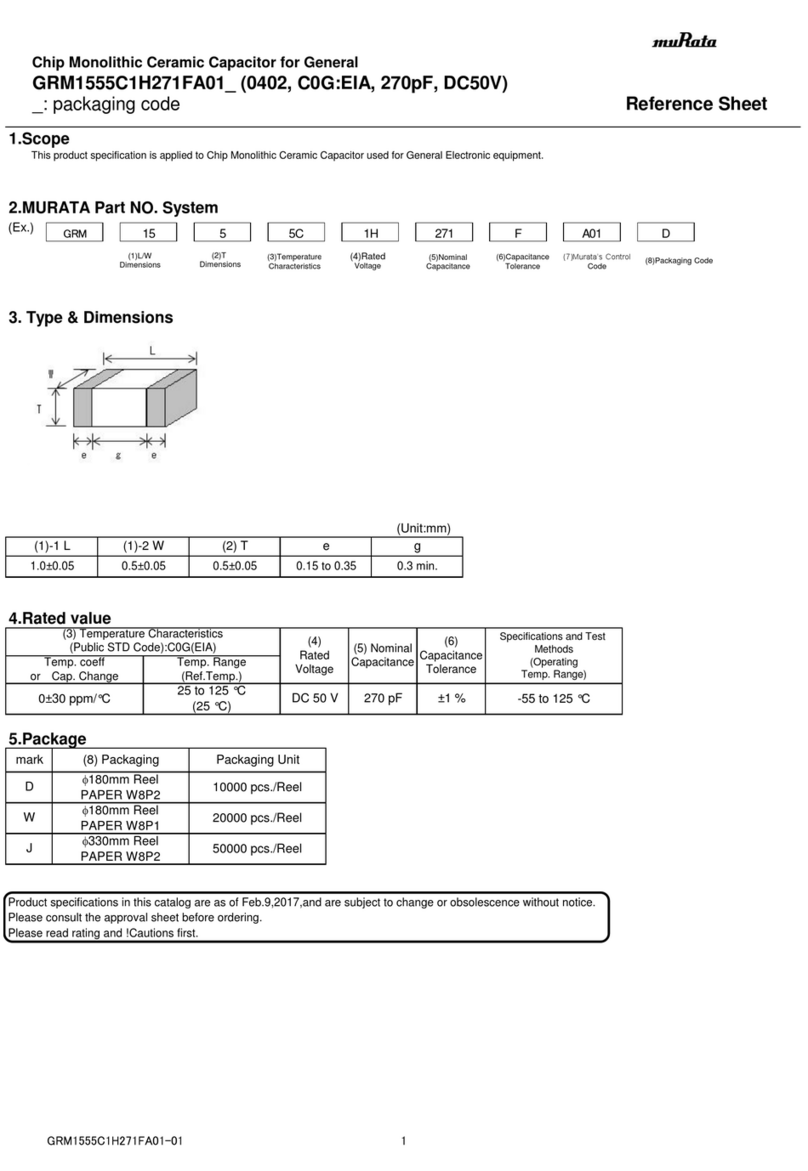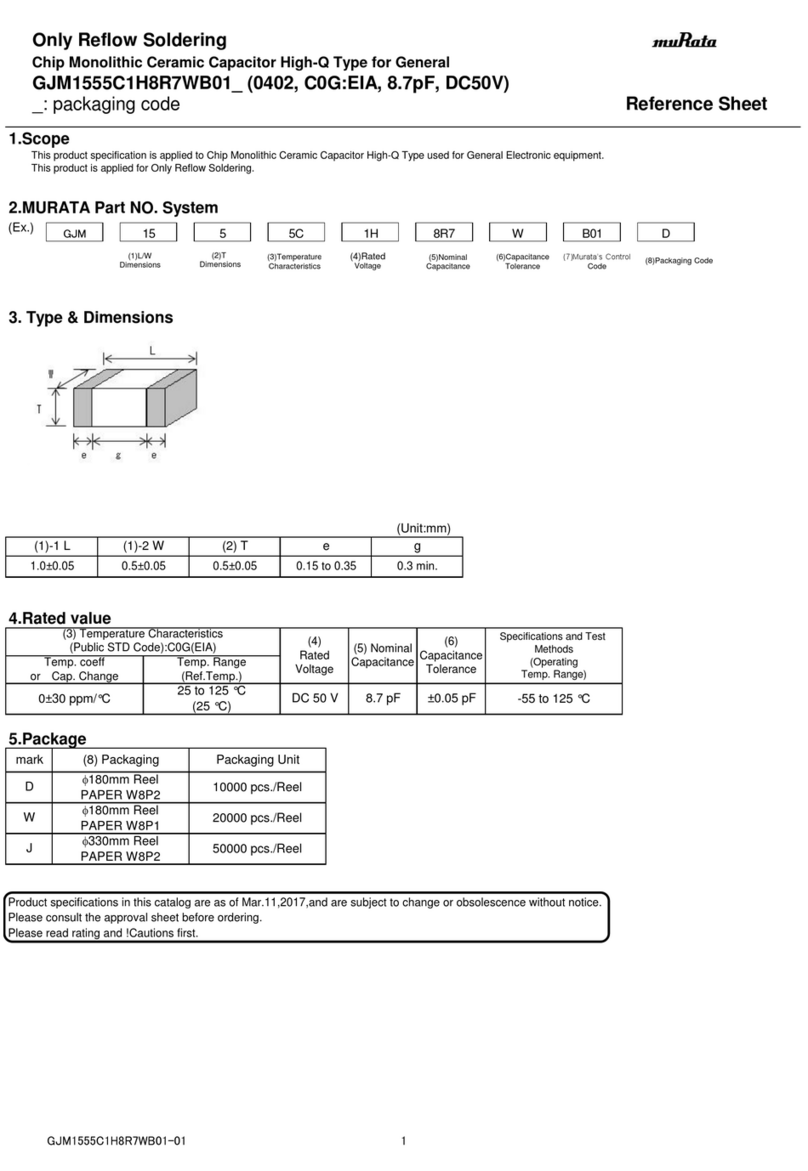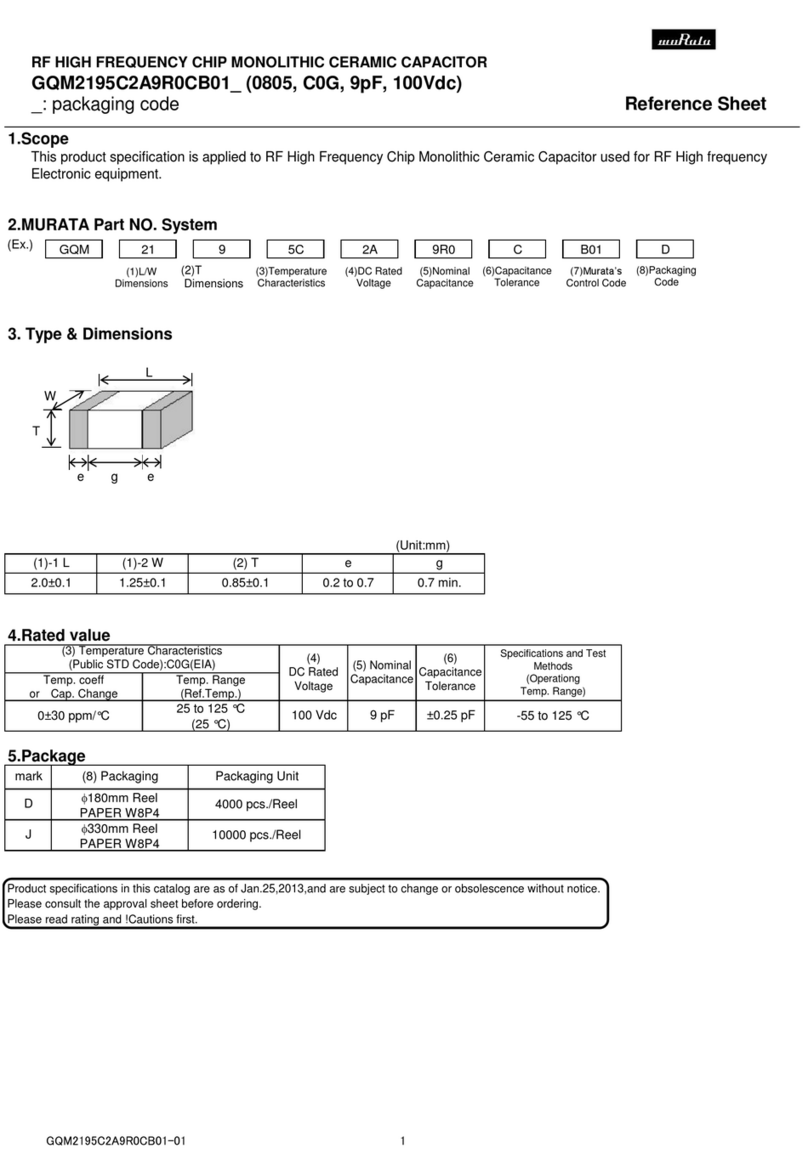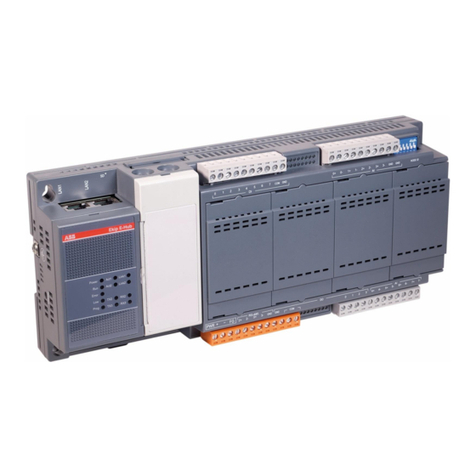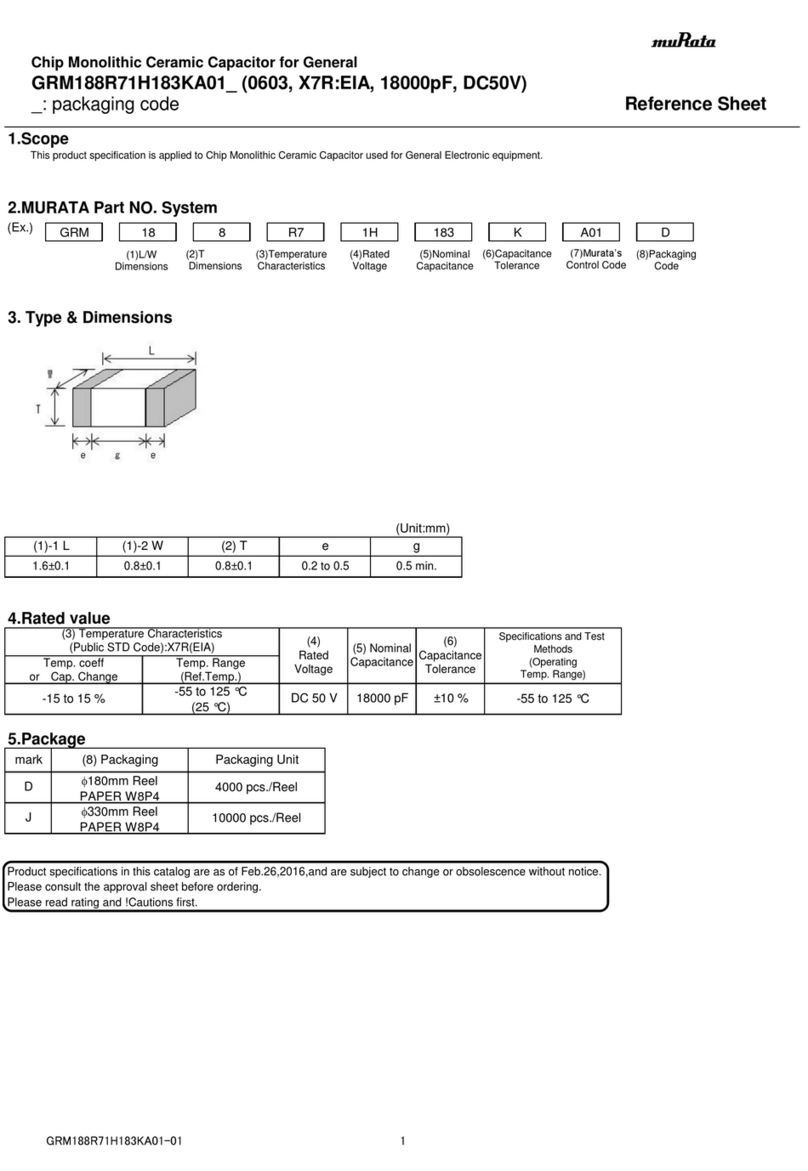Bird Electronic Econoload 8730A User manual

INSTRUCTION BOOK
ECONOLOAD®LOAD RESISTOR
SERIES 8730
INCLUDING MODELS 8730A, 8731
8732A, AND 8738A
©Copyright 2005 by Bird Electronic Corporation
Instruction Book P/N 920-8730S Rev. C
Econoload®and Termaline®are Registered
Trademarks of Bird Electronic Corporation

This Page Intentionally Left Blank

i
Safety Precautions
The following are general safety precautions that are not necessarily
related to any specific part or procedure and do not necessarily appear
elsewhere in this publication. These precautions must be thoroughly
understood and applied to all phases of operation and maintenance.
Keep Away From Live Circuits
Operating personnel must at all times observe normal safety regulations.
Do not replace components or make adjustments inside the equipment
with high voltage turned on. To avoid casualties, always remove power.
Shock Hazard
Do not remove the RF transmission line while RF power is present.
Do Not Service Or Adjust Alone
Under no circumstances should any personnel reach into an enclosure for
the purpose of service or adjustment of equipment except in the presence
of someone who is capable of rendering aid.
Safety Earth Ground
An uninterruptible earth safety ground must be supplied from the main
power source to test instruments. Grounding one conductor of a two
conductor power cable is not sufficient protection. Serious injury or death
can occur if this grounding is not properly supplied.
Chemical Hazard
Dry cleaning solvents for cleaning parts may be potentially dangerous.
Avoid inhalation of fumes or prolonged contact with skin.
Coolant may contain ethylene glycol. Avoid ingestion, inhaling of vapors
and eye and skin contact.
Resuscitation
Personnel working with or near high voltages should be familiar with
modern methods of resuscitation.

Bird 8730 Series Econoload RF Load Resistor
ii
Safety Symbols
NOTE: Calls attention to supplemental information.
Warning Statements
The following safety warnings appear in the text whenever the equipment
is in danger of damage and are shown here for emphasis.
WARNING
Warning notes call attention to a procedure, which if not correctly
performed could result in personal injury.
CAUTION
Caution notes call attention to a procedure, which if not correctly
performed could result in damage to the instrument.
This symbol indicates that a shock hazard exists if the
precautions in the instruction manual are not followed.
The caution symbol appears on the equipment indicating
there is important information in the instruction manual
regarding that particular area.
This symbol indicates that the unit radiates heat and
should not be touched while hot.
WARNING
Disconnect the unit from all power sources before servicing.
The unit may be energized from multiple sources.
The potential for electric shock exists.
WARNING
Improper wiring could result in electric shock and death.
WARNING
If the resistor breaks, there may be splinters or sharp pieces inside the
load housing. Be careful when repairing to avoid being cut.
WARNING
Never attempt to connect or disconnect RF equipment from the
transmission line while RF power is being applied.
Leaking RF energy is a potential health hazard.

iii
Caution Statements
The following equipment cautions appear in the text whenever the
equipment is in danger of damage and are shown here for emphasis.
CAUTION
Incorrect hose connections will reverse coolant flow and
could destroy the load.
CAUTION
Different control systems are used for 115 Vac and 230 Vac. Use the
correct interlock control for your voltage.
CAUTION
If installed, connect optional interlock before applying RF power.
CAUTION
Do not interrupt coolant supply. Even momentary
application of RF power while coolant is not circulating could
cause immediate destruction of the load
CAUTION
Do not remove the resistor plug. Any attempt to do so will cause
leakage and resistor damage.

Bird 8730 Series Econoload RF Load Resistor
iv
Safety Statements
USAGE
ANY USE OF THIS INSTRUMENT IN A MANNER NOT
SPECIFIED BY THE MANUFACTURER MAY IMPAIR THE
INSTRUMENT’S SAFETY PROTECTION.
USO
EL USO DE ESTE INSTRUMENTO DE MANERA NO ESPECIFICADA
POR EL FABRICANTE, PUEDE ANULAR LA PROTECCIÓN DE
SEGURIDAD DEL INSTRUMENTO.
BENUTZUNG
WIRD DAS GERÄT AUF ANDERE WEISE VERWENDET ALS VOM
HERSTELLER BESCHRIEBEN, KANN DIE GERÄTESICHERHEIT
BEEINTRÄCHTIGT WERDEN.
UTILISATION
TOUTE UTILISATION DE CET INSTRUMENT QUI N’EST PAS
EXPLICITEMENT PRÉVUE PAR LE FABRICANT PEUT
ENDOMMAGER LE DISPOSITIF DE PROTECTION DE
L’INSTRUMENT.
IMPIEGO
QUALORA QUESTO STRUMENTO VENISSE UTILIZZATO IN MODO
DIVERSO DA COME SPECIFICATO DAL PRODUTTORE LA
PROZIONE DI SICUREZZA POTREBBE VENIRNE COMPROMESSA.
SERVICE
SERVICING INSTRUCTIONS ARE FOR USE BY SERVICE -
TRAINED PERSONNEL ONLY. TO AVOID DANGEROUS
ELECTRIC SHOCK, DO NOT PERFORM ANY SERVICING UNLESS
QUALIFIED TO DO SO.
SERVICIO
LAS INSTRUCCIONES DE SERVICIO SON PARA USO EXCLUSIVO
DEL PERSONAL DE SERVICIO CAPACITADO. PARA EVITAR EL
PELIGRO DE DESCARGAS ELÉCTRICAS, NO REALICE NINGÚN
SERVICIO A MENOS QUE ESTÉ CAPACITADO PARA HACERIO.

v
WARTUNG
ANWEISUNGEN FÜR DIE WARTUNG DES GERÄTES GELTEN NUR
FÜR GESCHULTES FACHPERSONAL.
ZUR VERMEIDUNG GEFÄHRLICHE, ELEKTRISCHE SCHOCKS,
SIND WARTUNGSARBEITEN AUSSCHLIEßLICH VON
QUALIFIZIERTEM SERVICEPERSONAL DURCHZUFÜHREN.
ENTRENTIEN
L’EMPLOI DES INSTRUCTIONS D’ENTRETIEN DOIT ÊTRE
RÉSERVÉ AU PERSONNEL FORMÉ AUX OPÉRATIONS
D’ENTRETIEN. POUR PRÉVENIR UN CHOC ÉLECTRIQUE
DANGEREUX, NE PAS EFFECTUER D’ENTRETIEN SI L’ON N’A PAS
ÉTÉ QUALIFIÉ POUR CE FAIRE.
ASSISTENZA TECNICA
LE ISTRUZIONI RELATIVE ALL’ASSISTENZA SONO PREVISTE
ESCLUSIVAMENTE PER IL PERSONALE OPPORTUNAMENTE
ADDESTRATO. PER EVITARE PERICOLOSE SCOSSE ELETTRICHE
NON EFFETTUARRE ALCUNA RIPARAZIONE A MENO CHE
QUALIFICATI A FARLA.
CONNECT INTERLOCK TO TRANSMITTER/GENERATOR/
AMPLIFIER BEFORE OPERATING.
BRANCHER LE VERROUILLAGE À L’ÉMETTEUR/
GÉNÉRATEUR/AMPLIFICATEUR AVANT EMPLOI.
CONECTE EL INTERBLOQUEO AL TRANSMISOR/GENERADOR/
AMPLIFICADOR ANTES DE LA OPERACION.
VOR INBETRIEBNAHME VERRIEGELUNG AM SENDER/
GENERATOR/VERSTÄRKER ANSCHLIESSEN.
PRIMA DI METTERE IN FUNZIONE L’APPARECCHIO, COLLEGARE
IL DISPOSITIVO DI BLOCCO AL TRASMETTITORE/GENERATORE/
AMPLIFICATORE.

Bird 8730 Series Econoload RF Load Resistor
vi
About This Manual
This manual covers the Bird 8730A, 8731, 8732A, and 8738A Econoload
RF Load Resistor.
This instruction book is arranged so that essential information on safety
is in the front of the book. Reading the Safety Precautions before operat-
ing the equipment is strongly advised. The remainder of this instruction
book is divided into Chapters and Sections.
Operation
First time operators should read Chapter 1 - Introduction, and Chapter 3
- Installation, to get an overview of equipment capabilities and how to
install it. An experienced operator can refer to Chapter 4 - Operating
Instructions. All instructions necessary to operate the equipment are
contained in this chapter.
Maintenance
All personnel should be familiar with preventative maintenance found in
Chapter 5 - Maintenance. If a failure should occur, the troubleshooting
section will aid in isolating and repairing the failure. Parts lists and
repair instructions are also in this chapter.
Changes To The Manual
We have made every effort to ensure this manual is accurate at the time
of publication. If you should discover any errors or if you have suggestions
for improving this manual, please send your comment to our factory. This
manual may be periodically updated. When inquiring about updates to
this manual, refer to the part number and revision level on the title page.
Naming Conventions
The following terms will be used throughout this manual to refer to
certain components of the Econoload:
Econoload or Load: The entire unit. It contains the RESISTOR.
Resistor: A subcomponent of the LOAD. This is the ceramic resistor
which actually absorbs the RF power.

vii
Table of Contents
Introduction . . . . . . . . . . . . . . . . . . . . . . . . . . . . . . . 1
Features . . . . . . . . . . . . . . . . . . . . . . . . . . . . . . . . . . . 1
Items Supplied . . . . . . . . . . . . . . . . . . . . . . . . . . . . . . . . 1
Optional Items . . . . . . . . . . . . . . . . . . . . . . . . . . . . . . . . 1
Theory Of Operation . . . . . . . . . . . . . . . . . . . . . . . . . . 3
Resistor. . . . . . . . . . . . . . . . . . . . . . . . . . . . . . . . . . . . 3
Coolant . . . . . . . . . . . . . . . . . . . . . . . . . . . . . . . . . . . . 3
Optional Flow Interlock . . . . . . . . . . . . . . . . . . . . . . . . . . . 3
Optional Thermal Interlock (8732A Only) . . . . . . . . . . . . . . . . . 3
Calorimetry . . . . . . . . . . . . . . . . . . . . . . . . . . . . . . . . . 4
Installation . . . . . . . . . . . . . . . . . . . . . . . . . . . . . . . 5
Unpacking and Inspection . . . . . . . . . . . . . . . . . . . . . . . . . . 5
DC Resistance . . . . . . . . . . . . . . . . . . . . . . . . . . . . . . . . 5
Placement . . . . . . . . . . . . . . . . . . . . . . . . . . . . . . . . . . 5
Coolant. . . . . . . . . . . . . . . . . . . . . . . . . . . . . . . . . . . . . . 6
Hoses . . . . . . . . . . . . . . . . . . . . . . . . . . . . . . . . . . . . . 6
Interlock (Optional) . . . . . . . . . . . . . . . . . . . . . . . . . . . . . . . 7
Thermoswitch (8732A Only) (Optional). . . . . . . . . . . . . . . . . . . . . 8
Connecting RF Power . . . . . . . . . . . . . . . . . . . . . . . . . . . . . . 9
Operating Instructions . . . . . . . . . . . . . . . . . . . . . . . . 11
Operation without Interlock . . . . . . . . . . . . . . . . . . . . . . . . . . 11
Normal Operation . . . . . . . . . . . . . . . . . . . . . . . . . . . . . . 11
Shutdown. . . . . . . . . . . . . . . . . . . . . . . . . . . . . . . . . . . 11
Emergency Shutdown . . . . . . . . . . . . . . . . . . . . . . . . . . . . 11
Operation with the Optional Interlock . . . . . . . . . . . . . . . . . . . . . 12
Shutdown. . . . . . . . . . . . . . . . . . . . . . . . . . . . . . . . . . . 12
Emergency Shutdown . . . . . . . . . . . . . . . . . . . . . . . . . . . . 12

viii
Maintenance . . . . . . . . . . . . . . . . . . . . . . . . . . . . . 13
Troubleshooting . . . . . . . . . . . . . . . . . . . . . . . . . . . . . . . . . 13
Maintenance . . . . . . . . . . . . . . . . . . . . . . . . . . . . . . . . . . . 13
Cleaning . . . . . . . . . . . . . . . . . . . . . . . . . . . . . . . . . . . 13
Inspection . . . . . . . . . . . . . . . . . . . . . . . . . . . . . . . . . . 14
DC Resistance . . . . . . . . . . . . . . . . . . . . . . . . . . . . . . . . 14
Repair . . . . . . . . . . . . . . . . . . . . . . . . . . . . . . . . . . . . . . 15
Flow Switch . . . . . . . . . . . . . . . . . . . . . . . . . . . . . . . . . 15
Time Delay Switch . . . . . . . . . . . . . . . . . . . . . . . . . . . . . . 15
Safety Light . . . . . . . . . . . . . . . . . . . . . . . . . . . . . . . . . 16
Resistor Servicing . . . . . . . . . . . . . . . . . . . . . . . . . . . . . . . . 17
Resistor Removal. . . . . . . . . . . . . . . . . . . . . . . . . . . . . . . 18
Inspection . . . . . . . . . . . . . . . . . . . . . . . . . . . . . . . . . . 18
Resistor Replacement . . . . . . . . . . . . . . . . . . . . . . . . . . . . 18
Conductor Replacement . . . . . . . . . . . . . . . . . . . . . . . . . . . 19
Preparation for Storage or Shipment . . . . . . . . . . . . . . . . . . . . . . 20
Customer Service . . . . . . . . . . . . . . . . . . . . . . . . . . . . . . . . 20
Specifications . . . . . . . . . . . . . . . . . . . . . . . . . . . . . . . . . . 21
Replacement Parts . . . . . . . . . . . . . . . . . . . . . . . . . . . . . . . 22
Bird 8730A, 8732A, and 8738A . . . . . . . . . . . . . . . . . . . . . . . 22
Bird 8731 . . . . . . . . . . . . . . . . . . . . . . . . . . . . . . . . . . . 22
Interlock (Optional) . . . . . . . . . . . . . . . . . . . . . . . . . . . . . 23

1
Chapter 1 Introduction
Bird 8730 Series Econoloads are compact, nonradiating, low reflection
terminations for medium power RF lines. They dissipate up to 10 kW
with a VSWR of less than 1.1:1 from 1 kHz to 1000 MHz.
Features yUseable with CW, AM, FM, SSB, and TV modulation, and certain
pulse types. Contact Bird Electronic Corporation for information
on using Econoloads with pulsed signals.
yMake precise, calorimetric measurements by using an Econoload
with a Bird 6085 Calorimeter.
yDesigned for easy field repair of all components.
Items Supplied yLoad, Water-cooled
yInstruction Manual
Optional Items yControl system with red pilot light that turns on when the load is
working properly. Also has flow switch and 12 second time delay
interlock to ensure steady coolant flow before RF power is applied.

Bird 8730 Series Econoload RF Load Resistor
2
Figure 1
8730 Series
Econoload Outline
Drawing
TERMALINE®
ECONOLOAD®
2.5"
(
64 mm
)
12"
(305 mm)
Depends On
Connector
Depends On
Connector
Water
Outpu
t
Water
Input

3
Chapter 2 Theory Of Operation
Resistor Bird 8730 Series Econoloads consist of a thin-film-on-ceramic resistor
immersed in externally-supplied coolant. The coolant flows directly
over the resistor instead of using an intermediate heat transfer
system, reducing the load size to a minimum. After passing over the
entire length of the resistor, the coolant leaves the load and can
either be discarded or cooled in a heat exchanger and reused.
Coolant The load’s electrical and thermal performance is reduced by
impurities or chemical additives in the coolant, especially ones which
are deposited as scale on the resistor. This may cause the load to
overheat and fail. Salt water will have a similar effect and should not
be used. For recommended coolant, refer to “Coolant” on page 6 and to
“Specifications” on page 21.
Optional
Flow Interlock
A minimum coolant flow of four galons per minute is required at all
times to dissipate the heat from RF power. When the flow rate drops
below this point, the flow switch opens causing immediate
transmitter shutdown. The flow switch is a “normally open” type, and
is closed during normal operation.
After flow is restored, a time delay switch keeps the interlock open for
an additional 12 seconds. This ensures proper operation of the cooling
system before applying RF power, preventing resistor burnout.
Optional Thermal
Interlock
(8732A Only)
The 8732A can be supplied with an optional passive overtemperature
thermoswitch. Normally closed, it opens at a preset temperature,
turning off transmitter power. The temperature setting is preset at
the factor for either 72 or 79 °C (162 or 175 °F). The interlock system
will not permit use of the transmitter until the load has reached a
safe temperature.

Bird 8730 Series Econoload RF Load Resistor
4
Calorimetry Almost all the RF power in the load is transferred to the coolant as
heat. There is no heat transfer to the outer housing of the load,
leaving it at ambient temperature even at full power. The flow rate,
and the difference between the input and output coolant
temperatures, can be used to calculate the power dissipated in the
load with the following formula:
where
P = Power in kilowatts
k = 0.263 for temperature in °C, 0.146 for temp. in °F
Tout = Water temperature at the output of the load
Tin = Water temperature at the input to the load.
F = Water flow rate in gallons per minute
NOTE: This calculation is performed automatically in the Bird
6085 Calorimeter.
P = k ×(Tout – Tin) ×F

5
Chapter 3 Installation
This chapter provides information on site requirements, unpacking,
inspection, and preparing the Bird 8730 Series Econoload for use.
Unpacking and
Inspection
1. Carefully inspect the shipping container for signs of damage. If
damage is noticed, do not unpack the unit. Immediately notify the
shipping carrier and Bird Electronic Corporation.
2. If the container is not damaged, unpack the unit. Save the packing
materials in case the unit should need to be shipped again.
3. Inspect all of the components for visible signs of damage.
Immediately notify the shipping carrier and Bird Electronic
Corporation of equipment damage or missing parts.
DC Resistance Before first using the load, get a resistance baseline for future
maintenance. Refer to “DC Resistance” on page 14 for instructions.
Placement yDo not use outdoors or in areas of condensing humidity.
yVentilation or buffer space is not required. The Econoload may be
placed in very small spaces.
yThe load may be mounted in any position. Rotate the load so that
the warning label is visible and the water connections are easily
accessible.
yAccess to a coolant supply or pump is required. Make sure the
coolant supply can meet the required flow rate.
yTo use the optional interlock, AC power is required.

Bird 8730 Series Econoload RF Load Resistor
6
Coolant
For operation at 1kHz or lower, use only distilled water as the
coolant. For operation above 1kHz use distilled or potable water.
Refer to the specifications for the definition of potable water. If the
water quality is doubtful, use distilled water.
Hoses
The Econoload is supplied with standard 3/4” hose fittings. For rigid
piping, replace the hose adapters with 1/2” male pipe fittings. If the
optional flow switch is installed, it is attached to the water INPUT.
yThe Econoload’s water INPUT is located in the center of the back
of the load. Connect the coolant supply to the load’s INPUT.
Secure with hose clamps.
yThe Econoload’s water OUTPUT is on the rear side of the load, at
a 90° angle to the INPUT. Connect the coolant drain to the load’s
OUTPUT. Secure with hose clamps.
CAUTION
Incorrect hose connections will reverse coolant flow and
could destroy the load.

Installation
7
Interlock (Optional)
The interlock control box has four 1/4” mounting holes in a 5” x 5”
(127 x 127 mm) square. Mount it where the safety light will be clearly
visible. Wire the control box as follows (refer to Figure 2):
yConnect the flow switch leads to terminals 3 and 5.
yConnect the transmitter interlock to terminals 6 and 7.
yConnect the ac power source to terminals 2 and 3, making sure
that ac common is connected to terminal 2.
WARNING
Disconnect the unit from all power sources before servicing.
The unit may be energized from multiple sources.
The potential for electric shock exists.
WARNING
Improper wiring could result in electric shock and death.
CAUTION
If installed, connect optional interlock before applying RF power.
CAUTION
Different control systems are used for 115 Vac and 230 Vac. Use the
correct interlock control for your voltage.
Figure 2
Interlock
Connections
Flow Interlock Control
Trans.
Interlock
AC
Input
Common
WHITE
WHITE
BLACK
BLACK
YEL/WHT BLK/WHT
BLUE
ORANGE
VIOLET
GREY
Time Delay
Relay (NO)
12 sec.
Flow Switch (NO)
Red Lamp
1 2 3456 7

Bird 8730 Series Econoload RF Load Resistor
8
Thermoswitch (8732A Only) (Optional)
The 8732A, only, can be equipped with an optional interlock
thermoswitch, P/N 2450-095-x. To install or replace this:
1. Stand the unit with the water connectors up to prevent spills.
2. Remove the water outlet connector.
3. Replace the connector with the thermoswitch. Sparingly apply
pipe sealing compound to the external threads, only, of the
thermoswitch. Do not contaminate the coolant with pipe sealant.
4. Check for coolant leaks upon completion.
Connect the thermoswitch to the interlock as follows (see Figure 3):
1. Unscrew the large knurled ring-nut [A] at the lower end of the
coupling jack assembly. Pull it off the thermoswitch jack [B].
Unscrew the small knurled cover fitting from the base plug [D] of
the connector to release the base.
2. Thread the control switch wires through the clamp [E] with the
washers [F] inside and its threaded fitting in place. Use short tips
on the wires and put spaghetti sleeves over the ends if necessary.
3. Solder the switch leads to the lugs [G] of the connector base.
NOTE: The ring-nut [A] must be in place over the base plug [G]
with the knurled end facing out.
4. Screw on the cover ring, then fasten the cable clamp [E] in place
and tighten both yoke screws [H].
5. Put the plug back on the thermoswitch and tighten the nut [A].
CAUTION
If installed, connect optional interlock before applying RF power.
Figure 3
Thermoswitch
Assembly

Installation
9
Connecting RF Power
After installing the Econoload, the RF transmission line can be
attached using standard coaxial line coupling kits.
Swivel Flanged Coupling: To couple the swivel flange with a flanged
RF transmission line, use an appropriate coupling kit. Refer to
Figure 4 while following the instructions below:
yInsert the center bullet and push it in until it is fully seated.
yConnect the coaxial input in a straight line and push carefully on
the center conductor to close.
NOTE: The swivel flange on the load makes connection
independent of the orientation of the fixed flange on the coaxial
input outer conductor.
yInsert the bolt sets and tighten evenly all around to transmission
line manufacturer’s recommended torque. Use all of the bolts.
WARNING
Never attempt to connect or disconnect RF equipment from the
transmission line while RF power is being applied.
Leaking RF energy is a potential health hazard.
Figure 4
Swivel Flanged
Coupling
B
O
LT BULLET L
O
ADRF
CO
AXIAL LINE

Bird 8730 Series Econoload RF Load Resistor
10
Unflanged Coupling: To couple the unflanged connector with an
unflanged RF line, use an appropriate coupling kit. Refer to Figure 5
while following the instructions below:
yInsert the center bullet and bottom it on the midpoint nibs.
yPosition the outer sleeve, with clamping bands, over the input
connector.
ySet the transmission line snugly against the coupling stops.
yPosition the clamping bands evenly about 3/4” from the ends of
the sleeve.
yTighten the clamping bands.
Figure 5
Unflanged
Coupling
RF
CO
AXIAL
LINE
C
LAMPIN
G
BANDS
CO
NNE
C
T
O
R
SLEEVE
BULLET
L
O
AD
This manual suits for next models
4
Table of contents
Popular Industrial Electrical manuals by other brands
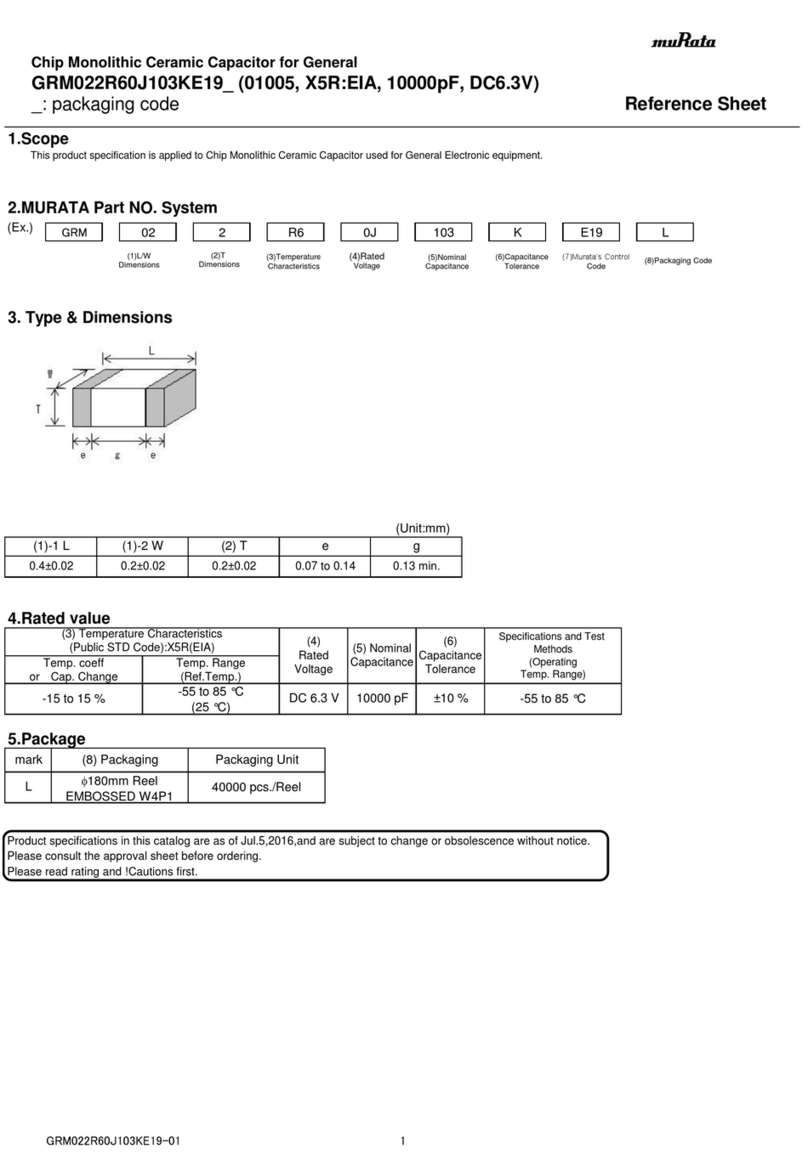
Murata
Murata GRM022R60J103KE19 Series Reference sheet

Murata
Murata GCM188R71H333JA55 Series Reference sheet
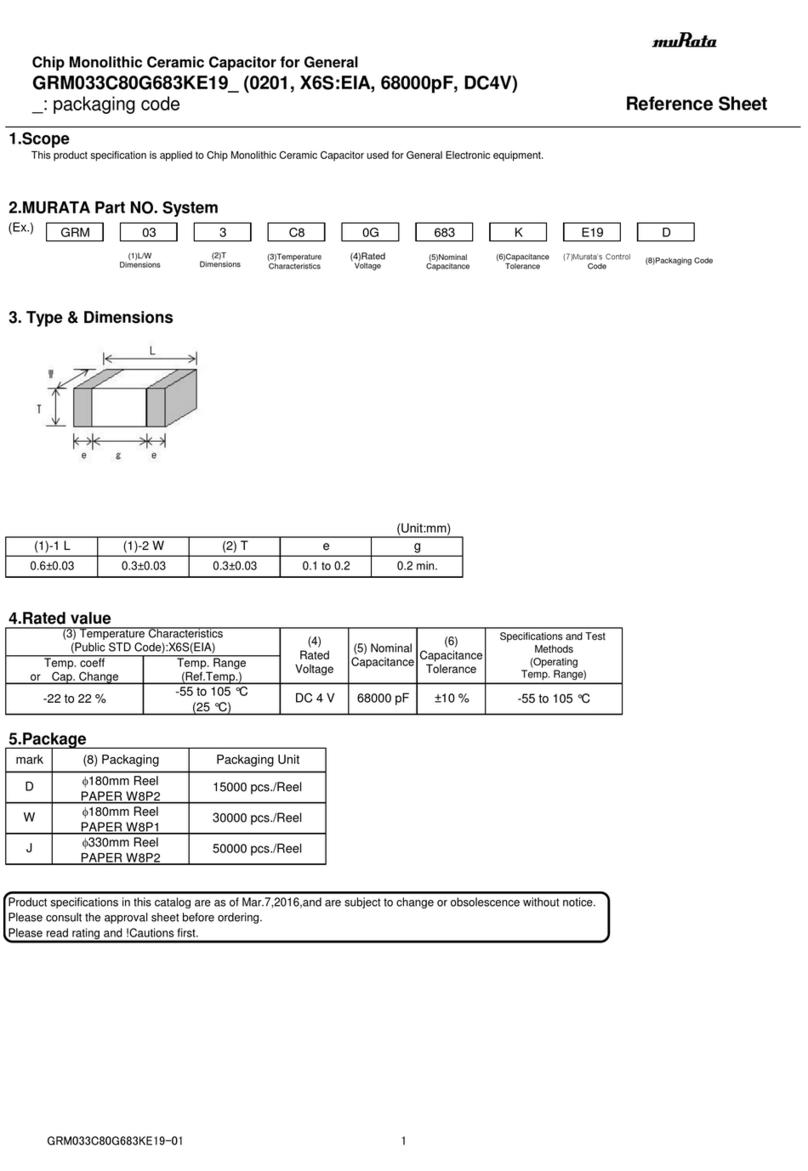
Murata
Murata GRM033C80G683KE19 Series Reference sheet
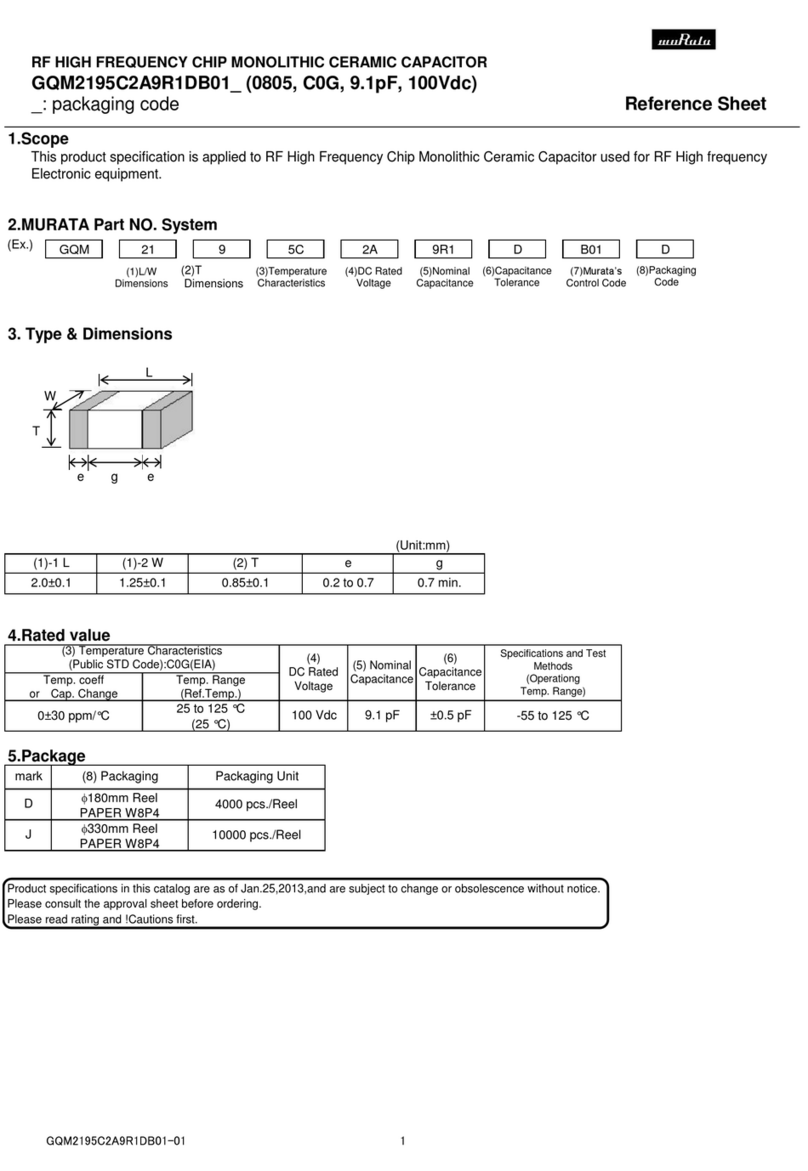
Murata
Murata GQM2195C2A9R1DB01 Series Reference sheet

Murata
Murata GRM1885C1H181JA01 Series Reference sheet
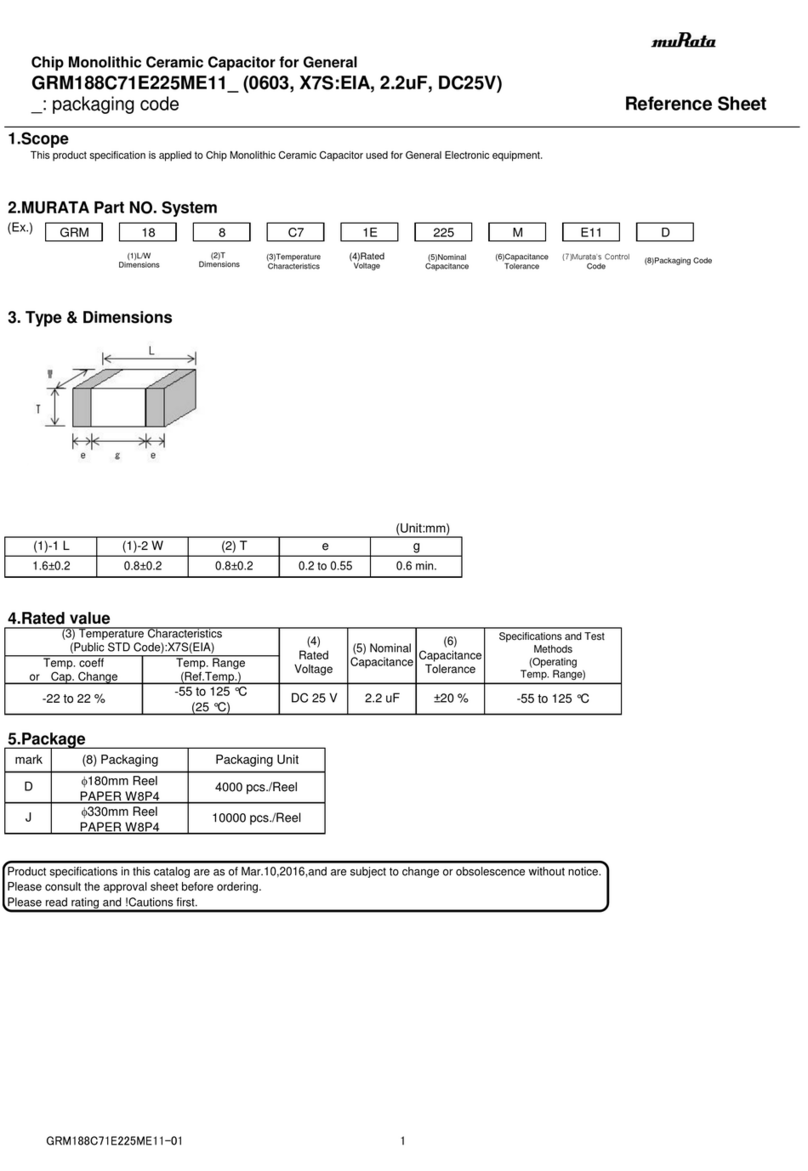
Murata
Murata GRM188C71E225ME11 Series Reference sheet
